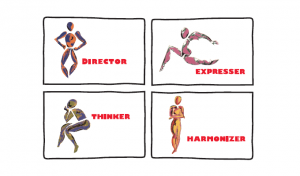
Research shows us people have four different styles of communication. We call these: Director, Expresser, Thinker and Harmonizer. Each style has its own way of seeing the world. Each favors a certain way of listening, responding, making decisions, and solving problems.
Most people use two styles more frequently; this blend determines how you communicate.
It’s especially important to understand your primary communication style, since this is the one you use most often. No style is best, but it may be to your advantage to play up one over another, depending on the situation.
Psychologists first noticed there were different communication styles in the 1960s.
Subsequent research, including research conducted by the author of Straight Talk®, confirmed that there are four scientifically distinct styles of communicating.
Straight Talk defines “communication style” as the specific way that one listens and responds.
Related Post: Where do our communication styles come from?
Because people have different styles, chances are that within any team or work group there will be conflicting approaches. Before team members can work together effectively, they need to be aware of these potential conflicts. They need to master certain tools to minimize these conflicts.
Here are three Straight Talk communication tools you can download and discuss with your team:
Now let’s move on to identifying communication styles through behaviors.
The chart below will help you sort through another person’s style. Circle each behavior that applies, then total the number of squares you circled in each column. The two columns that get the highest scores will tell you that person’s preferred styles of communicating.
Once you’ve circled two styles at the bottom of the chart, use the next chart to determine a person’s primary style.
Download this blog – How to Identify Communication Styles (PDF)
When meeting someone for the first time, there are three things to do:
My goal is to size someone up within five minutes. Ask a question like: “What do you do to stay current with trends in your business?” Or: “What kind of person is successful in your field?”
Then watch for clues.
You can’t rely on just one question. You’ve got to ask two or three to be sure. Weigh the number of times the person talks about feelings. Weigh the balance of inquiry and assertion.
Here are some questions that work well:
Watch how people interact with you. Do they engage in small talk? Or do they cut to the chase? Do they tell stories? Do they break an issue down into its constituent parts? Do they ask questions? Each of these is a trademark of a particular style.

In assessing a person’s style, observe the role that person is playing. A manager may feel she has to be assertive. It’s her job. But is she assertive by nature, or just playing the part? The balance of inquiry and assertion will tell you. The same thing is true of someone in a subordinate role. Is he probing by nature or because it’s required of him? There’s no simple key that will yield the correct answer every time. You simply have to practice observing.
Another trick is learning to recognize the assertive questioner. Some people temper their nature by disguising statements as questions. I recall a CEO who never asked: “When would your schedule permit?” She said: “Could you be here next week?” She laid out her desire very clearly – but tried to soften it by asking a question.
You’ll also learn to recognize the opposite: the passive asserter. “We’ve got a really good team here, and it’s taken a long time to build it. It’s very important here at XYZ Corp. that we have a good team.” On its own, that statement means relatively little. Certainly, no one’s going to challenge it. It is utterly safe and benign. It is a passive assertion.
Asserters like to run the show; probers defer to others and ask questions. Asserters leap to conclusions and take risks; probers look for confirmation and safety in numbers. Be attuned to the situation. An asserter may appear passive at first. But put him or her in a situation that requires someone to take charge, and a different style may emerge.
Observe where people invest their attention.
Do they talk about their family, or about their new car? If they tend to say things are “good” or “bad,” that’s the mark of the feeler. If their judgments are cast more in the words “right” and “wrong,” that’s a sign of a factual style. Again, you have to be careful not to be tricked by the situation. A person you know from church may have an entirely different style at work.

By tuning yourself to identify and understand each style, you’ll quickly learn to appreciate some of the subtleties in people’s communications – the hidden levels of meaning behind what they say, the types of things they pay attention to. This, in turn, will lead to more satisfying and more successful interactions. More important, as you begin to appreciate how people see things in four very different ways, you begin to appreciate how around us revolve four different worlds – the worlds of the Director, Expresser, Thinker & Harmonizer.
Learn more about Straight Talk Leadership Styles.
| Lesson 3: First Steps to Effective Communication | Lesson 5: The Four Communication Styles |
Comments are closed.
Dear Eric, I would like to congradulate you Straight Talk is simply brilliant.